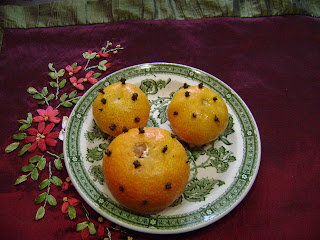My mum called me a few minutes ago asking me for the tarte Tatin recipe I made during Christmas. It was gone in 30 minutes and I must say that my sister, S. helped me make it. Not that it's difficult but she wanted to practice.
On that day I realised what a difference a good oven can make. Mine over here struggles and is not very powerful so my crusts and pastries don't come out as they're supposed to. Anyway, here goes:
Ingredients:
5-6 large apples, preferably Golden Delicious or Ginger Gold peeled and quartered
Juice of 1 lemon
1 ½ cups granulated sugar
6 tbs unsalted butter, divided
Juice of 1 lemon
1 ½ cups granulated sugar
6 tbs unsalted butter, divided
For the pâte brisée (shortcrust pastry):
2 1/2 cups all-purpose flour
1 teaspoon salt
1 teaspoon sugar
1 cup (2 sticks) unsalted butter, chilled and cut into small pieces
1/4 to 1/2 cup ice water
To make the dough (pâte brisée:):
-Combine the flour, salt and sugar in a bowl or food processor. Add the butter and process until the mixture resembles coarse crumbles.
Add ice water slowly, until the mixture holds together without being too wet or too sticky.
Make the dough into a ball and refrigerate for at least an hour.
-Toss the apple quarters in a bowl with the sugar and the lemon juice.
Melt 4 tablespoons of butter on a 28 cm skillet / pan over medium heat.
Add the remaining cup of sugar along with a few tablespoons of the apple-lemon juices.
Cook the mixture over medium-low heat, stirring regularly with a wooden spoon, for about 15 minutes, or until the mixture is a smooth, bubbly, pale caramel color.
-Remove the pan from the heat and carefully add apple quarters, arranging them rounded-side-down in a decorative pattern. Arrange a second layer of apples on top wherever they fit, closely packed. This second layer need not be terribly neat. Top the apples with the remaining 2 tablespoons of butter, cut into dice.
-Preheat the oven to 180 degrees.
-Cook the apples over medium-low heat for about 20 minutes, occasionally spooning the bubbling caramel liquid over them. Press them down gently with the back of a spoon — don’t worry if they shift a bit in the liquid; just move them back to where they were — and watch to make sure that no one area of the pan is bubbling more than another. Shift the pan as necessary so that the apples cook evenly. They are ready when the liquid in the pan has turned to a thick, amber ooze. The apples should still be slightly firm. Do not allow them to get entirely soft or the liquid to turn dark brown. Remove the pan from the heat.
-Remove the dough from the refrigerator. Knead and roll it making a circle as large as the skillet where the apples have been cooked (28 cm diameter). Carefully lay the pastry circle over the apples in the skillet, tucking the overlap down between the apples and the inside of the pan.
-Place the skillet on a rimmed baking sheet, and bake for about 30-35 minutes, until the pastry is dry and golden brown. Remove the skillet from the oven, and let it to rest for a minute or two. Tilt the pan and look down inside the edge: if there is a lot of juice, pour most of it off into the sink. Place a serving platter upside-down over the skillet and, working quickly and carefully (it’s hot!), invert the tart onto the platter. Rearrange any apple slices that may have slipped or stuck to the skillet. Serve warm or at room temperature, preferably with cream.
-Remove the pan from the heat and carefully add apple quarters, arranging them rounded-side-down in a decorative pattern. Arrange a second layer of apples on top wherever they fit, closely packed. This second layer need not be terribly neat. Top the apples with the remaining 2 tablespoons of butter, cut into dice.
-Preheat the oven to 180 degrees.
-Cook the apples over medium-low heat for about 20 minutes, occasionally spooning the bubbling caramel liquid over them. Press them down gently with the back of a spoon — don’t worry if they shift a bit in the liquid; just move them back to where they were — and watch to make sure that no one area of the pan is bubbling more than another. Shift the pan as necessary so that the apples cook evenly. They are ready when the liquid in the pan has turned to a thick, amber ooze. The apples should still be slightly firm. Do not allow them to get entirely soft or the liquid to turn dark brown. Remove the pan from the heat.
-Remove the dough from the refrigerator. Knead and roll it making a circle as large as the skillet where the apples have been cooked (28 cm diameter). Carefully lay the pastry circle over the apples in the skillet, tucking the overlap down between the apples and the inside of the pan.
-Place the skillet on a rimmed baking sheet, and bake for about 30-35 minutes, until the pastry is dry and golden brown. Remove the skillet from the oven, and let it to rest for a minute or two. Tilt the pan and look down inside the edge: if there is a lot of juice, pour most of it off into the sink. Place a serving platter upside-down over the skillet and, working quickly and carefully (it’s hot!), invert the tart onto the platter. Rearrange any apple slices that may have slipped or stuck to the skillet. Serve warm or at room temperature, preferably with cream.



















